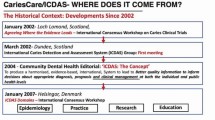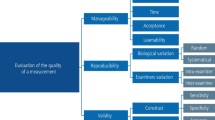Abstract
Introduction The International Caries Classification and Management System (ICCMS) was developed to standardise caries diagnosis, risk assessment and treatment decisions based on overall evidence. To evaluate its criteria in practice, a clinical trial assessed professionals' perceptions of two caries management systems.
Methods A perception questionnaire was administered to two groups: one using ICCMS criteria and the other based on professional experience criteria (non-ICCMS group). The online questionnaire included quantitative scale questions to measure effort and satisfaction and two open-ended questions to collect the positive and negative perceptions of dentists by using either criteria system. The questionnaires were administered six months after the study's implementation.
Results Both groups showed high levels of effort and satisfaction. Professionals using ICCMS reported more positive perceptions by citing improved diagnosis (71.4%) and standardised patient care (43%). However, they also noted negative aspects, such as increased number of questionnaires and records (58%), longer clinical sessions (43%) and higher rates of patient absenteeism (29%).
Conclusion Professionals who used the ICCMS had a positive outlook on the system, with benefits seen in diagnosis and patient monitoring. However, there is room for improvement in terms of automation and simplification to enhance the professional use of the system in the clinical setting.
Key points
-
Systems such as the International Caries Classification and Management System (ICCMS) can help professionals make clinical decisions and better follow-up patients based on evidence.
-
An improved, simplified and automated risk system can help professionals collect data and optimise clinical time, thus increasing their adherence to clinical practice as recommended by ICCMS guidelines.
-
Pragmatic clinical studies prove to be important for assessing the main barriers to the implementation of new evidence-based preventive strategies.
This is a preview of subscription content, access via your institution
Access options
Subscribe to this journal
Receive 24 print issues and online access
$259.00 per year
only $10.79 per issue
Buy this article
- Purchase on SpringerLink
- Instant access to full article PDF
Prices may be subject to local taxes which are calculated during checkout



Similar content being viewed by others
Data availability
The data that support the findings of this study are not publicly available due to privacy and ethical restrictions. The data that support the findings of this study are available from the corresponding author upon reasonable request.
References
Pitts N, Ekstrand K. International Caries Detection and Assessment System (ICDAS) and its International Caries Classification and Management System (ICCMS) - methods for staging of the caries process and enabling dentists to manage caries. Community Dent Oral Epidemiol 2013; 41: 41-52.
Ismail A I, Pitts N B, Tellez M, Authors of the International Caries Classification and Management System (ICCMS). The International Caries Classification and Management System (ICCMSTM) An Example of a Caries Management Pathway. BMC Oral Health 2015; 15: 9.
Pitts N B, Mazevet M E, Mayne C. Shaping the future of dental education: Caries as a case-study Eur J Dent Educ 2018; 22: 30-37.
International Caries Classification and Management System. ICCMS™ Guide for Practitioners and Educators. Available at https://www.iccms-web.com/uploads/asset/59284654c0a6f822230100.pdf (accessed June 2013).
Doméjean S, Banerjee A, Featherstone J D B. Caries risk/susceptibility assessment: its value in minimum intervention oral healthcare. Br Dent J 2017; 223: 191-197.
Elouafkaoui P, Bonetti D, Clarkson J, Stirling D, Young L, Cassie H. Is further intervention required to translate caries prevention and management recommendations into practice? Br Dent J 2015; DOI: 10.1038/sj.bdj.2014.1141.
Innes N P T, Frencken J E, Schwendicke F. Don't Know, Can't Do, Won't Change: Barriers to Moving Knowledge to Action in Managing the Carious Lesion. J Dent Res 2016; 95: 485-486.
Abreu-Placeres N, Newton J T, Pitts N et al. Understanding dentists' caries management: The COM-B ICCMSTM questionnaire. Community Dent Oral Epidemiol 2018; 46: 545-554.
Suga U S, Terada R S, Ubaldini A L et al. Factors that drive dentists towards or away from dental caries preventive measures: systematic review and metasummary. PLoS One 2014; 9: e107831.
Cashmore A W, Noller J, Ritchie J, Johnson B, Blinkhorn A S. Reorienting a paediatric oral health service towards prevention: lessons from a qualitative study of dental professionals. Health Promot J Austr 2011; 22: 17-21.
Ghasemi H, Murtomaa H, Torabzadeh H, Vehkalahti M M. Knowledge of and Attitudes towards Preventive Dental Care among Iranian Dentists. Eur J Dent 2007; 1: 222-229.
Schwendicke F, Doméjean S, Ricketts D, Peters M. Managing caries: the need to close the gap between the evidence base and current practice. Br Dent J 2015; 219: 433-438.
Treweek S, Zwarenstein M. Making trials matter: pragmatic and explanatory trials and the problem of applicability. Trials 2009; 10: 37.
Loudon K, Treweek S, Sullivan F, Donnan P, Thorpe K E, Zwarenstein M. The PRECIS-2 tool: designing trials that are fit for purpose. BMJ 2015; 350: h2147.
Vilanova-Saingery C, Bailleul-Forestier I, Vaysse F, Vergnes J-N, Marty M. Use and perception of nitrous oxide sedation by French dentists in private practice: a national survey. Eur Arch Paediatr Dent 2017; 18: 385-391.
O'Cathain A, Thomas K J. ‘Any other comments?' Open questions on questionnaires - a bane or a bonus to research? BMC Med Res Methodol 2004; 4: 25.
Kreitchmann R S, Abad F J, Ponsoda V, Nieto M D, Morillo D. Controlling for Response Biases in Self-Report Scales: Forced-Choice vs. Psychometric Modeling of Likert Items. Front Psychol 2019; 10: 2309.
Jick T D. Mixing Qualitative and Quantitative Methods: Triangulation in Action. Adm Sci Q 1979; 24: 602-611.
Hodge D R, Gillespie D F. Phrase completion scales: A better measurement approach than Likert scales? J Soc Serv Res 2007; 33: 1-12.
Campos C J G, Turato E R. Content analysis in studies using the clinical-qualitative method: application and perspectives. Rev Lat Am Enferm 2009; 17: 259-264.
Bardin L. Análise de Conteúdo. Lisboa: Edições, 2006.
Abreu-Placeres N, Newton J T, Avila A et al. How do dental practitioners, educators and students diagnose and manage caries risk and caries lesions? A COM-B analysis. Community Dent Oral Epidemiol 2023; 51: 265-273.
McCambridge J, Witton J, Elbourne D R. Systematic review of the Hawthorne effect: New concepts are needed to study research participation effects. J Clin Epidemiol 2014; 67: 267-277.
Bratthall D, Hänsel Petersson G. Cariogram - a multifactorial risk assessment model for a multifactorial disease. Community Dent Oral Epidemiol 2005; 33: 256-264.
Khallaf Y S, Hafez S, Shaalan O O. Evaluation of ICCMS versus CAMBRA Caries Risk Assessment Models Acquisition on Treatment Plan in Young Adult Population: A Randomized Clinical Trial. Clin Cosmet Investig Dent 2011; 13: 293-304.
Bhatia R, Vora E C, Panda A. Pediatric Dental Appointments No-show: Rates and Reasons. Int J Clin Pediatr Den; 2018; 11: 171-176.
Oude Rengerink K, Kalkman S, Collier S et al. Series: Pragmatic trials and real world evidence: Paper 3. Patient selection challenges and consequences. J Clin Epidemiol 2017; 89: 173-180.
Schulz K F, Grimes D A. Sample size calculations in randomised trials: mandatory and mystical. Lancet 2005; 365: 1348-1353.
McDonald A M, Knight R C, Campbell M K et al. What influences recruitment to randomised controlled trials? A review of trials funded by two UK funding agencies Trials 2006; 7: 9.
Leake J L, Birch S, Main P A, Ho E. Is regular visiting associated with lower costs? Analyzing service utilization patterns in the first nations population in Canada. J Public Health Dent 2006; 66: 116-122.
Riley P, Worthington H V, Clarkson J E, Beirne P V. Recall intervals for oral health in primary care patients. Cochrane Database Syst Rev 2013; DOI: 10.1002/14651858.CD004346.pub4.
Beltrán E O, Guiu L, Zarta O L, Pitts N B, Martignon S. Caries classification and management in the context of the CariesCare International (CCITM) consensus: a clinical case study. Br Dent J 2019; 22: 363-366.
Mejàre I, Axelsson S, Dahlén G et al. Caries risk assessment. A systematic review. Acta Odontol Scand 2014; 72: 81-91.
Martignon S, Pitts N B, Goffin G et al. CariesCare practice guide: consensus on evidence into practice. Br Dent J 2019; 227: 353-362.
Nainar S M H. Evidence-based Dental Care: Perspective on Levels of Evidence. Pediatr Dent 2017; 39: 273-277.
Author information
Authors and Affiliations
Contributions
Gabriela Sá Oliveira conceived the research idea, developed the survey, analysed the results and revised the manuscript. Mariana Minatel Braga developed the questionnaire and survey, analysed the results and revised the manuscript. The questionnaire was developed based on other studies and the authors, Jair Moreira Júnior and Kim Ekstrand, participated in the preparation of a first version. Matheus Ribeiro de Oliveira analysed the results and wrote the manuscript. Marcelo Bönecker developed the survey, analysed the results and revised the manuscript. All authors have agreed to the final submitted version of the manuscript.
Corresponding author
Ethics declarations
The authors declare no conflicts of interest.
This clinical trial was approved by the Research Ethics Committee of the University of São Paulo School of Dentistry according to protocol number 2201770 and registered in the database for registration of clinical studies Clinicaltrials.gov (NCT03488056). All parents provided consent to participate in the clinical study, and consent was also obtained from dental professionals for the present study. All stages of the study were conducted in accordance with the Declaration of Helsinki.
Rights and permissions
Springer Nature or its licensor (e.g. a society or other partner) holds exclusive rights to this article under a publishing agreement with the author(s) or other rightsholder(s); author self-archiving of the accepted manuscript version of this article is solely governed by the terms of such publishing agreement and applicable law.
About this article
Cite this article
Sá, G., Braga, M., Junior, J. et al. The professional perception of the International Caries Classification and Management System (ICCMS): a pragmatic randomised clinical trial. Br Dent J (2024). https://doi.org/10.1038/s41415-024-7510-9
Received:
Revised:
Accepted:
Published:
DOI: https://doi.org/10.1038/s41415-024-7510-9



